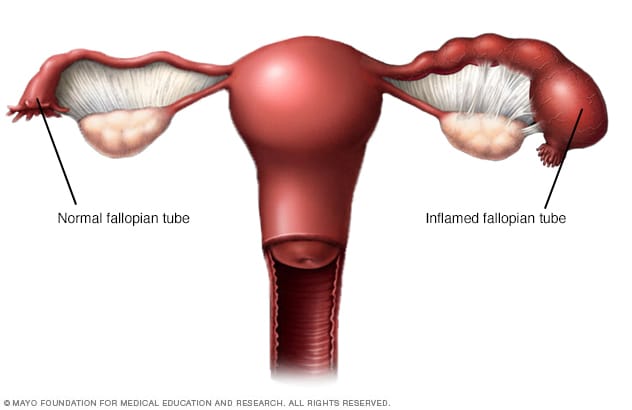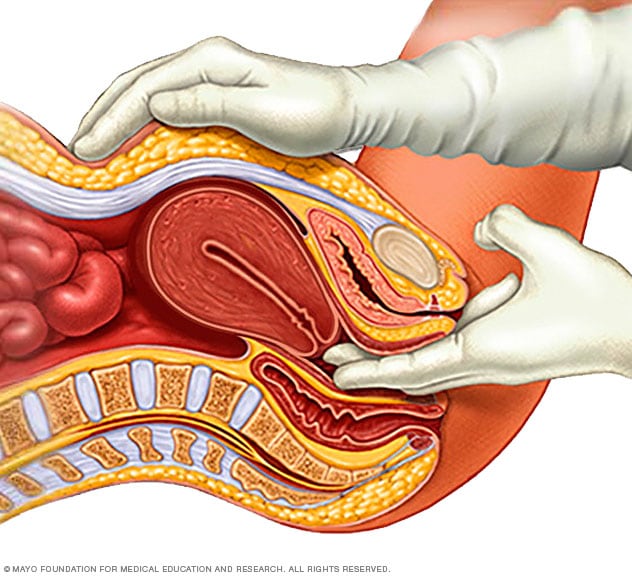Pelvic inflammatory disease (PID)
Overview
Pelvic inflammatory disease (PID) is an infection of the female reproductive organs. It most often occurs when sexually transmitted bacteria spread from your vagina to your uterus, fallopian tubes or ovaries.
The signs and symptoms of pelvic inflammatory disease can be subtle or mild. Some women don't experience any signs or symptoms. As a result, you might not realize you have it until you have trouble getting pregnant or you develop chronic pelvic pain.

Symptoms
The signs and symptoms of pelvic inflammatory disease might be mild and difficult to recognize. Some women don't have any signs or symptoms. When signs and symptoms of PID are present, they most often include:
- Pain — ranging from mild to severe — in your lower abdomen and pelvis
- Unusual or heavy vaginal discharge that may have an unpleasant odor
- Unusual bleeding from the vagina, especially during or after sex, or between periods
- Pain during sex
- Fever, sometimes with chills
- Painful, frequent or difficult urination
When to see a doctor
See your health care provider or seek urgent medical care if you experience:
- Severe pain low in your abdomen
- Nausea and vomiting, with an inability to keep anything down
- Fever, with a temperature higher than 101 F (38.3 C)
- Foul vaginal discharge
If you have signs and symptoms of PID that aren't severe, still see your provider as soon as possible. Vaginal discharge with an odor, painful urination or bleeding between periods can also be symptoms of a sexually transmitted infection (STI). If these signs and symptoms occur, stop having sex and see your provider soon. Prompt treatment of an STI can help prevent PID.
Causes
Many types of bacteria can cause PID, but gonorrhea or chlamydia infections are the most common. These bacteria are usually acquired during unprotected sex.
Less commonly, bacteria can enter your reproductive tract anytime the normal barrier created by the cervix is disturbed. This can happen during menstruation and after childbirth, miscarriage or abortion. Rarely, bacteria can also enter the reproductive tract during the insertion of an intrauterine device (IUD) — a form of long-term birth control — or any medical procedure that involves inserting instruments into the uterus.
Risk factors
A number of factors might increase your risk of pelvic inflammatory disease, including:
- Being sexually active and younger than 25 years old
- Having multiple sexual partners
- Being in a sexual relationship with someone who has more than one sex partner
- Having sex without a condom
- Douching regularly, which upsets the balance of good versus harmful bacteria in the vagina and might mask symptoms
- Having a history of pelvic inflammatory disease or a sexually transmitted infection
There is a small increased risk of PID after the insertion of an intrauterine device (IUD). This risk is generally confined to the first three weeks after insertion.
Complications
Untreated pelvic inflammatory disease might cause scar tissue and pockets of infected fluid (abscesses) to develop in the reproductive tract. These can cause permanent damage to the reproductive organs.
Complications from this damage might include:
- Ectopic pregnancy. PID is a major cause of tubal (ectopic) pregnancy. An ectopic pregnancy can occur when untreated PID has caused scar tissue to develop in the fallopian tubes. The scar tissue prevents the fertilized egg from making its way through the fallopian tube to implant in the uterus. Instead, the egg implants in the fallopian tube. Ectopic pregnancies can cause massive, life-threatening bleeding and require emergency medical attention.
- Infertility. Damage to your reproductive organs may cause infertility — the inability to become pregnant. The more times you've had PID, the greater your risk of infertility. Delaying treatment for PID also dramatically increases your risk of infertility.
- Chronic pelvic pain. Pelvic inflammatory disease can cause pelvic pain that might last for months or years. Scarring in your fallopian tubes and other pelvic organs can cause pain during intercourse and ovulation.
- Tubo-ovarian abscess. PID might cause an abscess — a collection of pus — to form in your reproductive tract. Most commonly, abscesses affect the fallopian tubes and ovaries, but they can also develop in the uterus or in other pelvic organs. If an abscess is left untreated, you could develop a life-threatening infection.
Prevention
To reduce your risk of pelvic inflammatory disease:
- Practice safe sex. Use condoms every time you have sex, limit your number of partners and ask about a potential partner's sexual history.
- Talk to your health care provider about contraception. Many forms of contraception do not protect against the development of PID. Using barrier methods, such as a condom, helps to reduce your risk. Even if you take birth control pills, use a condom every time you have sex with a new partner to protect against STIs.
- Get tested. If you're at risk of an STI, make an appointment with your provider for testing. Set up a regular screening schedule with your provider if needed. Early treatment of an STI gives you the best chance of avoiding PID.
- Request that your partner be tested. If you have pelvic inflammatory disease or an STI, advise your partner to be tested and treated. This can prevent the spread of STIs and possible recurrence of PID.
- Don't douche. Douching upsets the balance of bacteria in your vagina.
Diagnosis
There is no one test that can accurately diagnose pelvic inflammatory disease. Instead, your health care provider will rely on a combination of findings from:
- Your medical history. Your provider will likely ask about your sexual habits, history of sexually transmitted infections and method of birth control.
- Signs and symptoms. Tell your provider about any symptoms you're experiencing, even if they're mild.
- A pelvic exam. During the exam, your provider will check your pelvic region for tenderness and swelling. Your provider may also use cotton swabs to take fluid samples from your vagina and cervix. The samples will be tested at a lab for signs of infection and organisms such as gonorrhea and chlamydia.
- Blood and urine tests. These tests may be used to test for pregnancy, HIV or other sexually transmitted infections, or to measure white blood cell counts or other markers of infection or inflammation.
- Ultrasound. This test uses sound waves to create images of your reproductive organs.
If the diagnosis is still unclear, you may need additional tests, such as:
- Laparoscopy. During this procedure, your provider inserts a thin, lighted instrument through a small incision in your abdomen to view your pelvic organs.
- Endometrial biopsy. During this procedure, your provider inserts a thin tube into the uterus to remove a small sample of endometrial tissue. The tissue is tested for signs of infection and inflammation.

Treatment
Prompt treatment with medicine can get rid of the infection that causes pelvic inflammatory disease. But there's no way to reverse any scarring or damage to the reproductive tract that PID might have caused. Treatment for PID most often includes:
- Antibiotics. Your health care provider will prescribe a combination of antibiotics to start immediately. After receiving your lab test results, your provider might adjust your prescription to better match what's causing the infection. You'll likely follow up with your provider after three days to make sure the treatment is working. Be sure to take all of your medication, even if you start to feel better after a few days.
- Treatment for your partner. To prevent reinfection with an STI, your sexual partner or partners should be examined and treated. Infected partners might not have any noticeable symptoms.
- Temporary abstinence. Avoid sexual intercourse until treatment is completed and symptoms have resolved.
If you're pregnant, seriously ill, have a suspected abscess or haven't responded to oral medications, you might need hospitalization. You might receive intravenous antibiotics, followed by antibiotics you take by mouth.
Surgery is rarely needed. However, if an abscess ruptures or threatens to rupture, your provider might drain it. You might also need surgery if you don't respond to antibiotic treatment or have a questionable diagnosis, such as when one or more of the signs or symptoms of PID are absent.
Coping and support
Pelvic inflammatory disease can bring up difficult or stressful feelings. You may be dealing with the diagnosis of a sexually transmitted infection, possible infertility or chronic pain. To help you cope with the ups and downs of your diagnosis, consider these strategies:
- Get treatment. PID is most often caused by a sexually transmitted infection. Finding out that you have an STI can be traumatic for you or your partner. Nevertheless, you and your partner should both seek immediate treatment to lessen the severity of PID and to prevent reinfection.
- Be prepared. If you've experienced more than one episode of pelvic inflammatory disease, you're at greater risk of infertility. If you've been trying to get pregnant without success, make an appointment for an infertility evaluation. Ask your provider to explain the steps for infertility testing and treatment. Understanding the process may help reduce your anxiety.
- Seek support. Although sexual health, infertility and chronic pain can be deeply personal issues, reach out to your partner, close family members or friends, or a professional for support. Many online support groups allow you to maintain your anonymity while you discuss your concerns.
Preparing for your appointment
If you have signs or symptoms of pelvic inflammatory disease, make an appointment to see your health care provider.
Here's some information on what you can do to get ready and what to expect from your provider.
What you can do
- Be aware of any pre-appointment restrictions. At the time you make the appointment, ask if there's anything you need to do in advance.
- Write down any symptoms you're experiencing, including any that might seem unrelated to the reason you scheduled the appointment.
- Make a list of all medications, vitamins or supplements that you're taking.
- Write down questions to ask your provider.
Some basic questions to ask include:
- What kinds of tests do I need?
- Is this a sexually transmitted infection?
- Should my partner be tested or treated?
- Do I need to stop having sex during treatment? How long should I wait?
- How can I prevent future episodes of pelvic inflammatory disease?
- Will this affect my ability to become pregnant?
- Is there a generic alternative to the medicine you're prescribing me?
- Can I be treated at home? Or will I need to go to a hospital?
- Do you have any printed materials that I can take with me? What websites do you recommend?
- Do I need to come back for a follow-up visit?
What to expect from your doctor
Be ready to answer a number of questions, such as:
- Do you have a new sexual partner or multiple partners?
- Do you always use condoms?
- When did you first begin experiencing symptoms?
- What are your symptoms?
- Are you experiencing any pelvic pain?
- How severe are your symptoms?
Last Updated Apr 30, 2022
© 2024 Mayo Foundation for Medical Education and Research (MFMER). All rights reserved. Terms of Use




